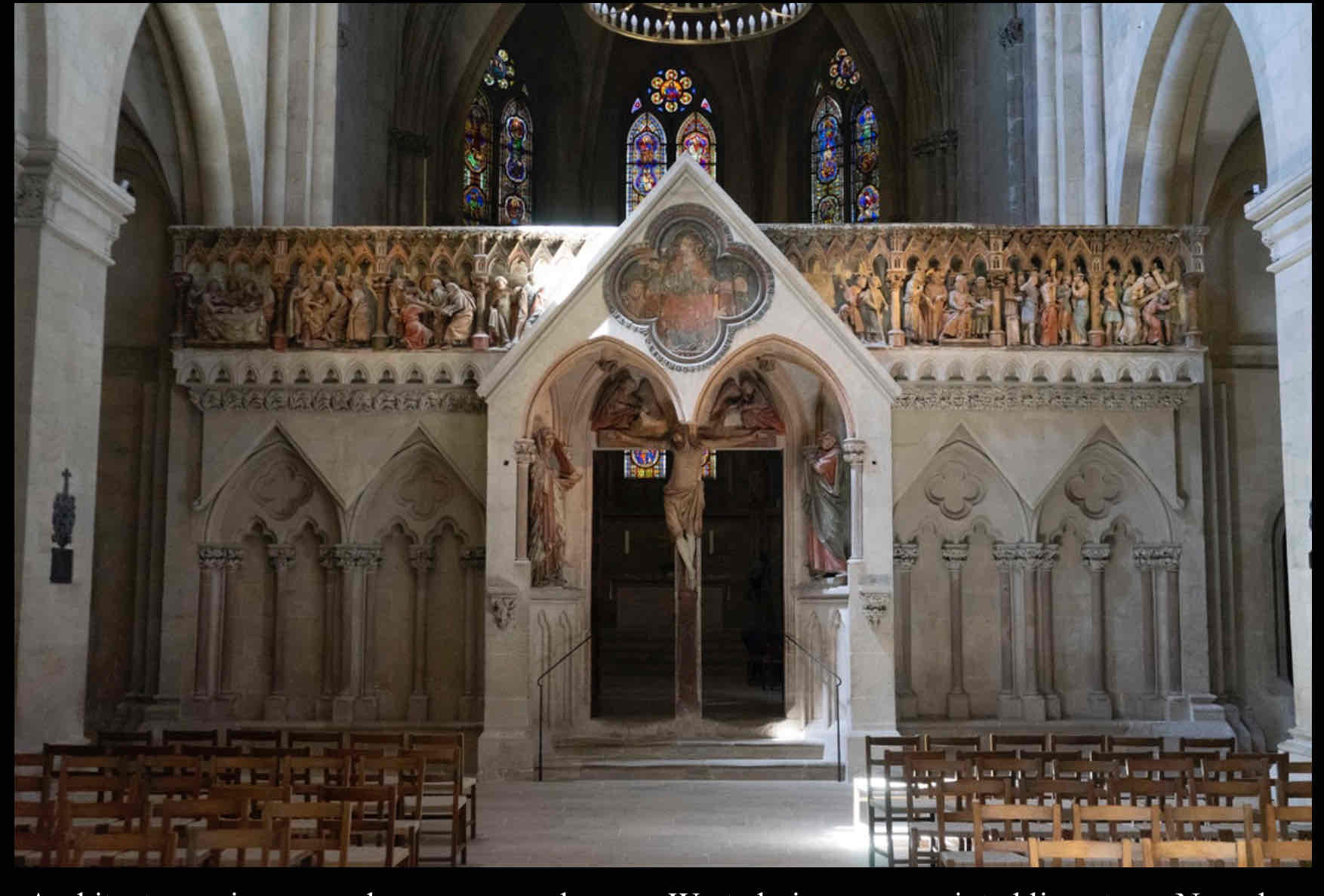RISD THAD H102 MIDTERM SPRING 2024 (copy)
1/64
Earn XP
Description and Tags
Lectures, Readings, Key Images - Information from midterm study guide by Arlie & key image information from Koji, and a little of my notes https://docs.google.com/document/d/1vCTod3J94QQxYRnfIFjCbmEyAzGvqQnfahuUy9lcJmk/edit?usp=share_link note: did not include all information for some stuff because too long
Name | Mastery | Learn | Test | Matching | Spaced |
|---|
No study sessions yet.
65 Terms
Bee Wing Lace Neckpiece
Luci Jockel (JM 16)
2021
Resonates with the lecture's exploration of design as a cultural practice that extends beyond aesthetics and purpose, reflecting cultural attitudes and values (in this case, environmentalism, as well as referring to the tradition of lace making in Rhode Island).

Side chair model DCM
Ray and Charles Eames
1946
While the chair’s functionalist approach reflects a historical context of providing practical solutions for a mass audience, it’s categorization as “good design” by western designers underscores the inherent limitations and potential exclusions associated with “universal” design claims.

Ulm School of Design student furniture
Max Bill, Hans Gugelot, and Paul Hildinger
1954
Signifies the commitment to practical and universal design principles while prompting critical reflection on the limitations and inclusivity challenges associated with universality. These works encapsulate the ethos of the Ulm School while contributing to discussions on the universal nature of design.

Stool rattan and fabric cushion
Isamu Kenmochi
1963
Exemplifies the embrace of functionalist and "universal" design approaches by other cultures. Notably, it integrates the Japanese cultural tradition of rattan weaving, showcasing a fusion of functionality with distinct cultural elements during this period.

Tripé de Ferro chair
Lina Bo Bardi
1950
Similarly embraces a functionalist and "universal" design approach while integrating other cultural elements, specifically Brazilian cattle ranching. This chair exemplifies the fusion of functionality with distinctive Brazilian cultural motifs, showcasing design's capacity to incorporate local traditions within the context of “good design”.

The Great Mosque of Xi’an
Early Ming Dynasty
As an Islamic mosque in China, it illustrates the diversity and cultural exchange within the Islamic world and serves as a challenge to the restrictive classification of "Islamic Art" by Western Orientalists, which tends to narrowly focus on Arabian, Persian, and similar influences.

Earring
11th-12th century CE
The critical aspect of any object’s inclusion in the MET’s display of Islamic Art lies in the museum's intent and interpretation. If the museum consciously aims to present a more comprehensive and diverse picture of Islamic art by including objects that challenge preconceived notions, the earring becomes a tool for broadening perspectives. However, if its display reinforces stereotypical views without addressing the complexity and variety within Islamic art, it may perpetuate the issue of pigeonholing Islamic art as one type of art.

Muqarnas Dome
12th-13th century
A highly calculative mathematical piece that apprehends the divine through the artistic immersion viewers experience. Ornamental art is devalued by the west for its association to “traditional”

The Grammar of Ornament, Persian No.2 and Indian No.3
Owen Jones
1865
Typifies the Western tendency to compartmentalize Islamic art. Reflects hierarchical views, categorizing non-western modes of design as inferior to the western

1851 Great Exhibition temporary building
Owen Jones
1851
Symbolizes Western attitudes toward tradition and reason, reflecting a focus on monumental structures and grand exhibitions as markers of artistic achievement. This aligns with the lecture's discussion on the prioritization of elite architectural works and the shaping of Western perspectives in categorizing art

Calligraphic Roundel
Late 16th-early 17th century CE
Represents the emphasis on calligraphy, geometry, and ornamentation in various art forms within Islamic traditions. The inscription, one of the ninety-nine names of God, showcases the significance of calligraphy as "the geometry of the soul."

Iket Kepala (Man’s Headcloth)
ca. 1850-1900 CE
A representation of Southeast Asian culture where Islamic imagery is integrated into traditional textiles. The headcloth features pseudo-Arabic words and the name Allah (SWT), showcasing the synthesis of Islamic, Hindu, Buddhist, and animist influences.

Poster exhibition of Farid Belkahia
Mohamed Melehi
1966
Offers a contemporary interpretation of script through geometric abstraction and Kufic script. Created by the Moroccan artist Mohamed Melehi, the piece reflects a freestyle approach, blending modern aesthetics with traditional elements.

Qasr Al-Mshatta façade (detail)
Umayyad period, 8th-century CE
Features 28 equal triangles, showcasing the importance of ornamentation in Islamic art as a complex relationship of forms. The detailing reflects a profound engagement with geometry and design, highlighting the lecture's point that these geometric elements don't have a finite endpoint but can infinitely evolve, in a mirror to the creation of the world.

Detail from the exterior of the Great Mosque of Córdoba
Rebuilt during the Umayyad Dynasty (661-750 CE
Reflects the concept of impermanence, covering the monument with no direct connection to the interior. The relationship with nature, the abstraction of divine patterns through tessellation, and the idea of unity in ornamentation contribute to the broader theme of Islamic art as a reflection of creation and a unique perspective on the world.

Double-page illustration of Rashid-ad-Din’s “Jāmi’ al-tawārīkh (Compendium of chronicles)”
Rashid-ad-Din
14th century CE
An example of paintings that do not follow western perspective, rather utilized a distorted sense of space to highlight multiple events in time. Viewers are free to enter and exit the piece at any point.

“Pair of Eagles” folio from Manafi’ al-Hayawan (On the Usefulness of Animals)
Ibn Bakhtishu
ca. 1300 CE
The folio illustrates the impact of Chinese art on the Iranian tradition, highlighting the cultural synthesis that occurred as a result of the Mongol conquest. This reflects the cross-cultural influences and exchanges during this period.

Night Revels of Han Xizai
Gu Hongzhong
937-975 CE
The emphasis on multiple vanishing points enhances the sense of interaction and movement within the painting. This aligns with the lecture's exploration of Persian painting introducing alternative spatial approaches that diverge from the linear perspective commonly found in European art.

The Geographer
Johannes Vermeer
1668-69
Vermeer's composition, influenced by Renaissance perspective, is discussed in connection with Decartes' notion of a singular eye. This reflects the conflation of vision and truth in the Western tradition, reinforcing Western sentiments of superiority in comparison to “primitive” Eastern perspective
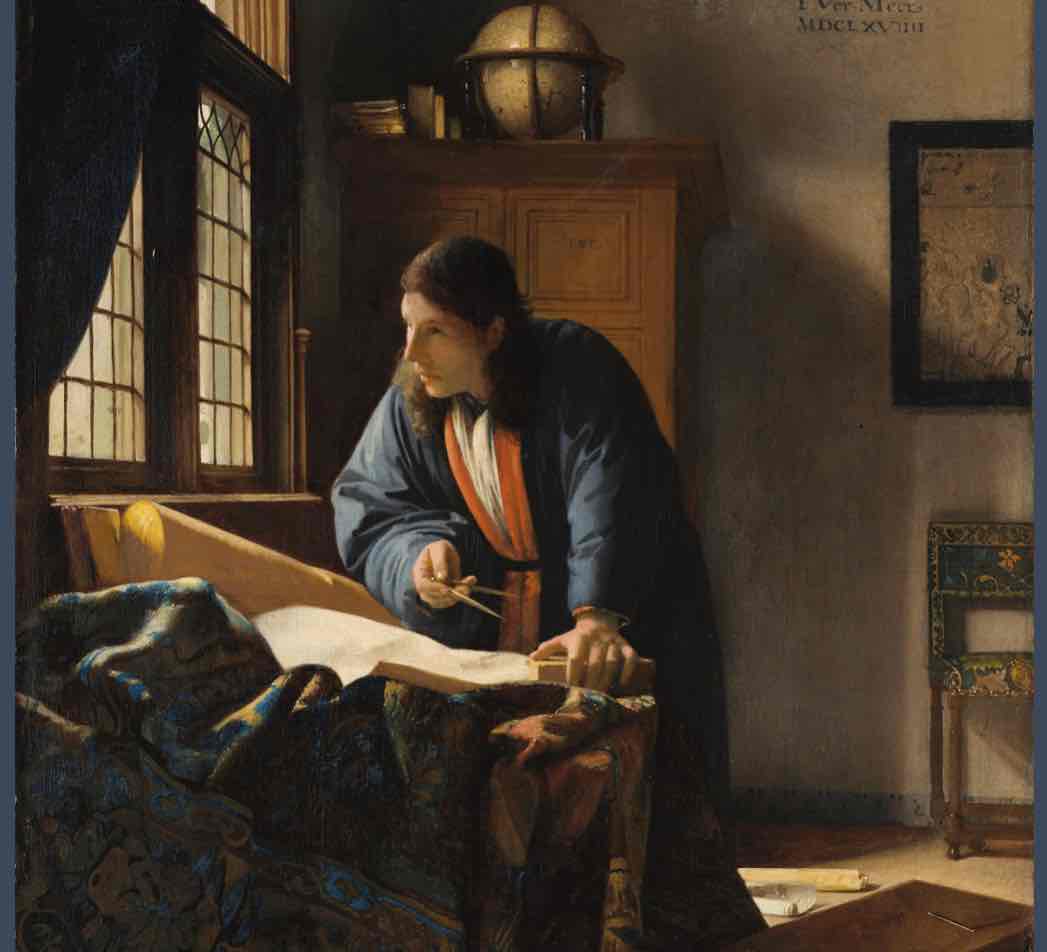
Yusuf and Zulaikha (Joseph pursued by Potiphar’s wife)
Kamal al-Din Bihzad
ca. 1488
In Islamic art, including Persian miniature painting, perspective is approached differently, often emphasizing intricate geometric designs, flattened space, and multiple viewpoints. This alternative spatial conception challenges the Eurocentric notion of perspective as the sole standard of artistic excellence, highlighting the diversity and sophistication of non-Western artistic traditions

Textile fragment with Nasrid Coat of Arms
ca. 1400
Represents the artistic legacy of the Arab Nasrid dynasty, which ruled over the Alhambra palace city in Granada, Spain during the 14th century. The intricate design and craftsmanship of the fragment, featuring the Nasrid Coat of Arms, exemplify the cross-cultural influences and the rich artistic heritage of Islamic, Jewish, and Christian traditions that flourished in the Iberian Peninsula during this period of Muslim caliphate rule.

Hall of Prayer, The Great Mosque of Córdoba
784-786 CE
Reflects the deep cultural connections and cross-cultural interactions that characterized Islamic Spain during this period. Constructed by Muslims establishing a vibrant culture in Spain, the mosque exemplifies the fusion of Islamic architectural traditions with local influences, as well as serves as a communal space that holds memories and tributes to the Syrian homeland.

Los Milagros Aqueduct
100-300 CE
Over the centuries, this aqueduct has become not just a functional structure but also a symbol of wonder and admiration, earning the moniker “Aqueduct of the Miracles." The aqueduct's architectural complexity, characterized by its blend of orderly structure and visual chaos, reflects the dynamic interplay between tradition and innovation (such as Roman and Islamic architectual elements), embodying a dialogue between past and present civilizations.

The Mihrab of the Great Mosque Córdoba
784-786 CE
Showcases the fusion of pre-existing regional traditions with innovative Islamic design elements. This architectural marvel not only facilitates the practical function of indicating the direction of Mecca for prayer but also symbolizes the Muslim world's ability to adapt and develop architectural styles based on local traditions.

Court of the Lions (Patio de los Leones)
The Alhambra Palace and Fortress
1362 CE
Emerges as a quintessential example of Islamic architecture during the Golden Age of Spain. As Muslims brought their architectural expertise and cultural influences from regions like Syria to Spain, they transformed the Mediterranean landscape, islamizing it and leaving an indelible mark on the architectural heritage of the Iberian Peninsula.

Femmes d’Alger dans leur appartement (Women of Algiers in their Apartment)
Eugène Delacroix
1834
Depicts a scene of four Algerian women in their lavishly decorated apartment, presenting them as exotic subjects for the European viewer's gaze. Delacroix's depiction of opium use and sexual connotations further underscores the Orientalist discourse that justifies colonial domination and exploitation.

Snake Charmer
Jean-Léon Gérôme
1879
Embodies the Orientalist perspective prevalent during the late 19th century, as evidenced by its portrayal of exoticism and cultural otherness. This painting aligns with themes of Orientalist logic in presenting the world as an exhibition, as depicted through the lens of European colonial dominance.
The ornamentations on the walls hint at the former glory of the East, now in a state of neglect and decay

Bonaparte Visiting the Plague Victims of Jaffa
Antoine-Jean Gros
1804
In this painting, Napoleon Bonaparte is portrayed as a divine figure, transcending the horrors of disease as he visits plague victims in Israel. Through such artistic representations, European powers perpetuated Orientalist narratives that justified their colonial dominance and portrayed the "other" as in need of their intervention and guidance.

A group of Egyptians and imported donkeys from Cairo on the Rue du Caire at the Paris Exposition
1889
Reflects a romanticized view of Egyptian culture, characterized by Western fascination with the exotic and primitive. By importing donkey drivers and their animals from Cairo to Paris, Delort sought to immerse visitors in an imagined, Westernized version of Cairo, reinforcing stereotypes and perceptions of the Orient as lesser-than and otherworldly.

Great Exhibition of the Works of Industry of All Nations
1851
These exhibitions aimed to showcase the cultures and achievements of various nations, but often portrayed the Middle East through staged scenes laden with Orientalist stereotypes. The Middle Eastern pavilions perpetuated Western supremacist notions, framing the region as and morally inferior to Western Christianity.

“Venus” of Willendorf
25-23.000 BP, discovered 1908
While traditionally interpreted as a fertility symbol due to its exaggerated features emphasizing aspects of fertility and maternity, such as large breasts and a rounded abdomen, recent scholarship suggests that this figurine also represents aspects of textile production. The reference to weaving techniques being used in its production indicates a connection between the Venus figurine and weaving culture among women

Terracotta lekythos (oil flask)
Amasis Painter, Greek
550-530 BCE
This ancient Greek artifact depicts scenes of women engaging in textile-related activities, such as preparing wool and weaving cloth. This aligns with the lecture's emphasis on the archaeological evidence globally indicating women's involvement in fiber processing, and weaving, highlighting their contributions to the economy while managing domestic responsibilities.

Women Preparing Newly Woven Silk
Song dynasty 12th century
Provides a representation of the involvement of women in textile production during ancient times. Depicting scenes of luxuriously adorned court ladies engaging in various stages of silk production, such as pounding silk, preparing thread, sewing, stretching, and ironing silk cloth, the artwork highlights the significance of women's roles in silk production rituals, known as gongcan or "palace sericulture"

Imperially Commissioned Pictures of Tilling and Weaving
Yuzhi gengzhi tu
Jiao Bingzhen
Kangxi Period, c. 17-18th century
Commissioned pictures like these played a significant role in documenting and commemorating the agricultural and weaving processes, showcasing the importance of these activities in Chinese society

Ceremonial huipil (traditional blouse)
Maker unidentified
Symbolizes the ethnic identity of the Mayan people of Guatemala but also serves as a tribute to the vital role of women in preserving cultural heritage. Traditionally made with handwoven cloth on a backstrap loom by women, the huipil embodies centuries of skill and tradition passed down from generation to generation.

Tse’ Hone (Diné: Rock that Tells a Story aka Newspaper Rock
In the context of exploring the diverse functions of writing beyond recording spoken language, "Tse’ Hone" holds significance as a tangible example of writing serving as a medium for storytelling and cultural expression

Rock art petroglyphs / Shang bronze inscriptions
Exemplify the diverse functions of pictographic writing beyond mere recording of spoken language. These ancient forms of writing, spanning from the Shang dynasty to later periods, served as mediums for storytelling, religious rituals, and historical documentation.

Shang oracle bone script
Dating back over 3000 years, these inscriptions served a dual purpose of divination and record-keeping for the Shang dynasty. Despite its ancient origins, oracle bone script laid the foundation for the evolution of Chinese writing systems, ultimately shaping the modern characters still in use today

Ai Weiwei “Crabs”
Both works epitomize the concept of symbolic communication through visual art. Much like "Shuang Xi," which symbolizes "double happiness" through visual imagery, "Crabs" communicates layers of meaning beyond literal script, demonstrating the diverse ways in which art serves as a medium for expression and cultural discourse.

Qiu zhijie Writing the “Orchid Pavilion Preface” One Thousand Times
Serves as an example of the intersection between calligraphy, repetition, and artistic expression. By meticulously copying Wang Xizhi's revered "Preface to the Poems composed at the Orchid Pavilion," Qiu underscores the idea that writing is not solely about conveying information but also about embodying a form of spiritual and artistic meditation.

Foiled plate with rocks, plants, and melons
Yuan dynasty (1271-1368), 14th century
Reflects the evolving aesthetics of Chinese porcelain influenced by foreign trade, particularly with Persia, during the Song dynasty. This piece showcases the integration of Islamic-inspired blue and white underglaze designs, highlighting the cultural exchange and interaction between China and Persia. It symbolizes the dynamic nature of identity and artistic expression, emphasizing the fluidity of cultural influences over time.

Koryo (Goryeo) celadon maebyong with incised dragons
c. 12th century
Celadon ceramics showcase the mastery of Korean potters who adapted and refined techniques borrowed from China. This piece underscores the cultural exchange and innovation that characterized East Asian ceramic production, highlighting Korea's significant contribution to the development of celadon ware.
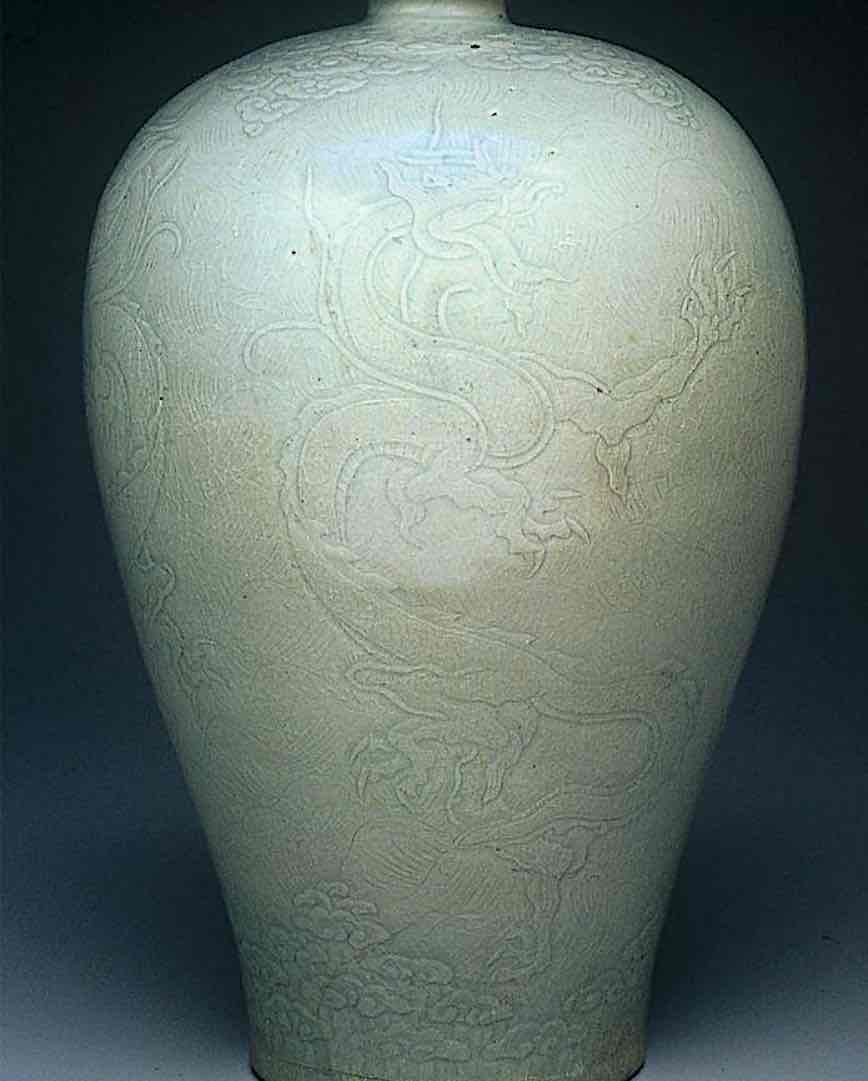
Fission Time
Li Xiaofeng
2018
Encapsulates the intersection of Chinese heritage and global influences. Using porcelain from the Ming and Qing dynasties, Li reimagines the traditional qipao dress, popularized in the 1930s-40s by Western culture, to explore themes of globalization, cultural hybridity, and the circulation of materials.

Still Life with Moor and Porcelain Vessels
Jurriaen van Streek
c. 1670
Captures the allure of blue and white porcelain, a prized symbol of wealth in western culture. Through the portrayal of exotic figures alongside prized porcelain vessels, the artwork prompts viewers to contemplate themes of wealth, status, and identity intertwined with global trade and exchange during the 17th century.

Chini-khana (porcelain house)
1607-1611
Showcases the cultural significance of porcelain in Persian art and architecture. Underscores the influence of porcelain on various cultures beyond its country of origin, illustrating its widespread appeal and symbolic value across different regions.

Artificial Rock
Zhan Wang
2001
Replication of the DongTien rock forms found in Chinese Gardens as important centerpieces shaping gardens (refer to Mysterious Heavens reading). These structures were admired similarly to how calligraphy was a free-flowing art form. The sense of dynamic form, energy, and occurring rocks in various materials, including jade, glass, and ceramics, is made of steel, challenging us to redefine the parameters of tradition and the modern, contemporary world.

Early Spring
Guo Xi
1072
Embodies the quasi-religious reverence for nature prevalent in Chinese culture, suggesting that nature surpasses humanity in importance. Guo Xi's masterpiece invites viewers to immerse themselves in the tranquil beauty of the landscape, offering a sense of renewal and connection to the natural cycles of life amidst urbanization.

Huijing Pond
Huijing Pond in Yuyuan Garden, Shanghai, epitomizes the profound significance of Chinese garden design within the broader context of landscape aesthetics. As a central feature of the garden, Huijing Hall symbolizes joy and glory, serving as a space for contemplation and appreciation of the surrounding waterscape.

Jade stone peak Yulinglong
Serves as a captivating testament to the profound reverence for nature and harmony within Chinese garden design. Despite its considerable weight, the rock's presence epitomizes a deep bond with the earth, evoking ancient spiritual connections to natural elements and the celestial realm. Through its strategic placement and symbolic significance, the Jade Stone Peak embodies the interplay of darkness and light, yin and yang, echoing themes of balance and harmony inherent in Chinese landscape aesthetics.
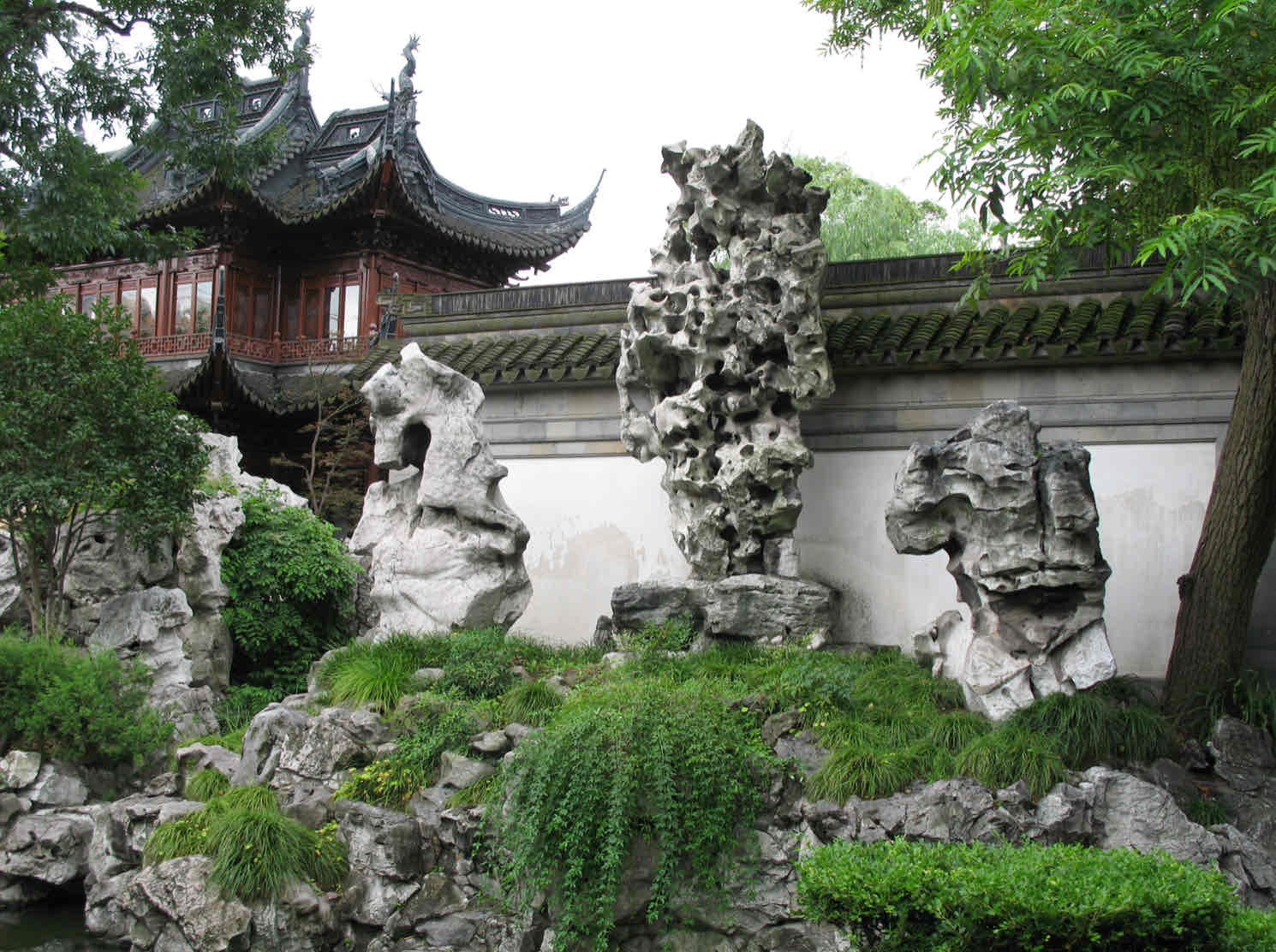
Dragon Wall
Encapsulates the essence of Chinese landscape aesthetics, where nature intertwines seamlessly with cultural symbolism. As integral components of the garden's design, the Dragon Walls not only demarcate different areas but also serve as conduits for the flow of energy, imperial power, and storytelling, enriching the visitor's experience with layers of meaning drawn from both nature and mythology.

Tombstone of Katerina Vilioni
June 1342
As the gravesite of an Italian woman connected to China through the Silk Road, this tombstone's iconography is noteworthy as it blends Chinese aesthetic elements with European Christian imagery. Through the medium of the tombstone, scholars can unravel the complexities of medieval identity, challenge Eurocentric narratives of the Middle Ages, and appreciate the interconnectedness of global cultures during this era of history.
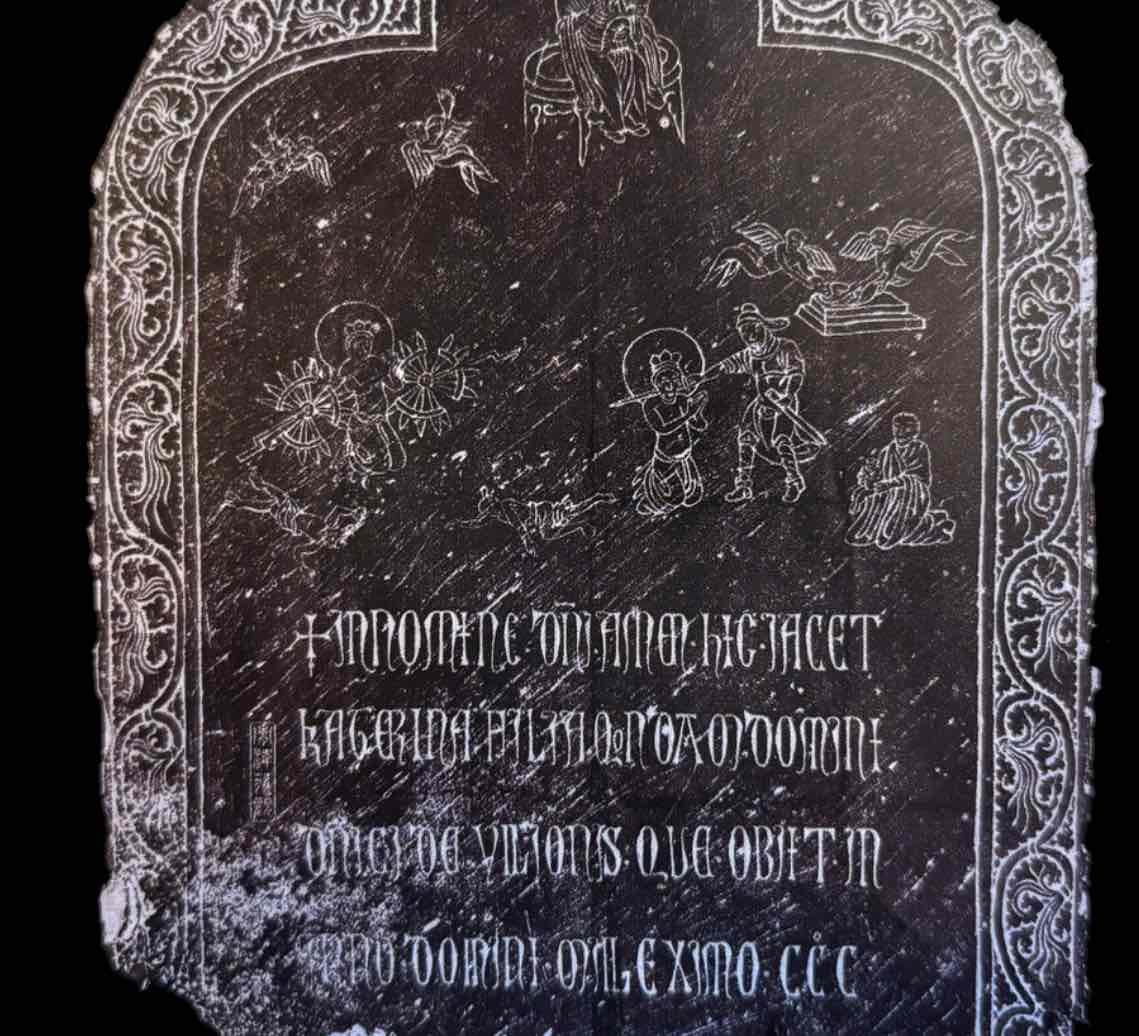
Lewis Chess Pieces
Late 12th - 13th century
Reflects the interconnectedness of medieval societies. These British chess pieces, discovered in Scotland, highlights the global reach of medieval trade and cultural exchange, as they were likely made from materials obtained through Viking encounters with Indigenous Inuit peoples, particularly from Greenland.

The Book of Images of Fixed Stars
al-Husayn ibn ‘Abd ar-Rahmān al-Sūfī
1009
Underscores the cultural subjectivity inherent in interpreting celestial phenomena. Through works like this, scholars can appreciate the multiplicity of perspectives and the richness of knowledge across different cultural contexts during the medieval period. The book serves as a practical tool for celestial navigation and timekeeping, reflecting the Islamic world's advanced understanding of astronomy and its integration into daily life.
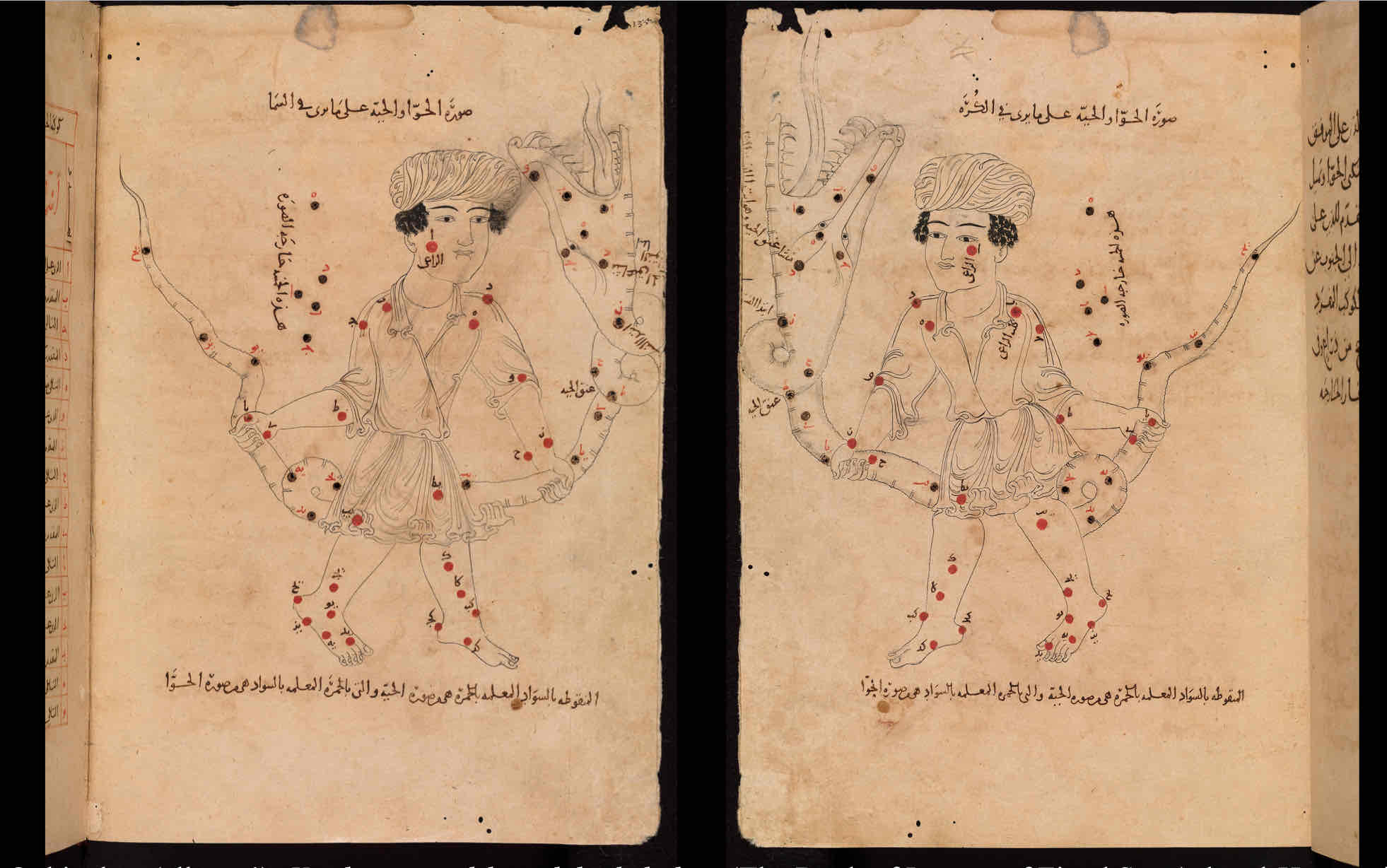
The Star Mantel of Emperor Henry II
Makers once known
1018
The embroidered inscriptions reflect cultural influences from the Byzantine Empire and Ottonian manuscript illuminations, illustrating the adaptation and reinterpretation of artistic styles across regions. Through artifacts like the Star Mantel, scholars can appreciate the intricate layers of cultural exchange and the rich tapestry of medieval societies.

“The Zodiac Man”
Pol de Limbourg
1409
The figure's body is associated with different astrological signs, reflecting the belief in the interconnectedness between celestial bodies and human health. Through artworks like "The Zodiac Man," scholars can observe how cultural contexts shape the interpretation and application of astronomical knowledge, highlighting the diversity of experiences with astrology across different societies.

Reliquary Purse of Saint Stephan
Artist(s) once known
ca. 815-830 CE
Exemplifies the significance of reliquaries in transforming ordinary objects into vessels of profound meaning. Despite its subtle narrative elements, such as a discreet cross symbolizing Saint Stephen's martyrdom by stoning, its elaborate design elevates the purported relics within, granting them validation and spiritual significance.

Cathedral of Santiago de Compostela, view of the nave elevation
Architects and engineers once known
1075-1122 CE
Acts as a monumental symbol of pilgrimage in Christianity, particularly to the relic of Saint James. The cathedral's role in fostering pilgrimage routes, such as the Camino de Santiago, underscores its enduring significance as a cultural and historical landmark, embodying the intersection of religious devotion, architecture, and human experience.

The reliquary of St. Foy
c. 1000 CE with later additions
The reliquary’s deliberate use of "spoila" from Roman statues, including the head, enhances St. Foy's relic's authenticity and prestige, reflecting the medieval reverence for Roman art and contributing to the relic's cultural significance.

Last Judgement Tympanum
Artist(s) once known
c. 1130 CE
Adorning the entrance of the church, it serves as a powerful visual representation of the final judgment, warning pilgrims of the consequences of sin. This intricate artwork, often translated by monks to pilgrims, sets the tone for their spiritual journey and underscores the importance of redemption and piety in medieval Christian pilgrimage.

Pilgrim’s Badge for the Shrine of St. Thomas Becket
1320-1375 CE
Holds significance as a tangible symbol of pilgrimage devotion. Crafted from tin, these badges were popular souvenirs for pilgrims visiting the shrine of St. Thomas Becket at Canterbury Cathedral. They served as personal mementos and outward signs of the pilgrims' spiritual journey, reflecting the widespread practice of pilgrimage in medieval Europe and the veneration of saintly relics.

Hagia Sophia Cathedral
Anthemois of Tralles and Isidore of Miletus
532-37 CE
Its innovative features, including the massive dome supported by pendentives and a sophisticated structural support system, represent a pioneering engineering achievement. The cathedral's strategic use of light, facilitated by expansive windows and openings, creates a transcendent atmosphere, elevating the spiritual experience of visitors. As a "total work of art," every aspect of its construction contributes to its enduring significance as an architectural masterpiece in religious reverence.

East end, Basilica Cathedral of St. Denis
Architects and engineers once known
Planned with Abbot Suger
1140-44
Marks a significant development in Gothic architecture. The introduction of groin arches allowed for more open spaces and increased natural light, a departure from the Romanesque style. This reflects the lecture's exploration of how medieval cathedrals evolved to engage the senses and emotions of the beholder. Additionally, the use of groin arches, which had earlier roots in Islamic architecture, suggests cultural exchange and communication between different civilizations, echoing the lecture's theme of architectural influences transcending geographical and cultural boundaries.

Cantigas de Santa Maria (Songs of Holy Mary)
Painter once known
Written by and for Alfonso X of Castile, Spain
1221-1224 CE
The popularity of this chant exemplifies the integration of music and spirituality in medieval cathedral culture. These songs, accompanied by vibrant illustrations, were intended for worship, meditation, and expressing devotion to the Virgin Mary. The emphasis on music in cathedrals aligns with the lecture's exploration of architecture as a multisensory experience, where sound contributes to the spiritual ambiance.

Censer
Maker once known
13th century
Incense, often used during religious ceremonies, rituals, and processions, played a significant role in enhancing the sensory atmosphere within cathedral spaces. The use of censers, like this one, highlights the integration of ritual objects into the architectural and spiritual fabric of medieval religious practice, emphasizing the holistic approach to worship and devotion.

West choir screen in Naumburg Cathedral
Artists once known
1250 CE
Serves as a physical and emotional threshold within the sacred space. Adorned with expressive statues of Jesus, Mary, and John, the screen adds an aura of mystery and solemnity to the cathedral interior. As visitors approach, they are compelled to pause and contemplate their presence in relation to the divine, embodied by the statues, fostering a heightened sense of spiritual awareness and connection.
